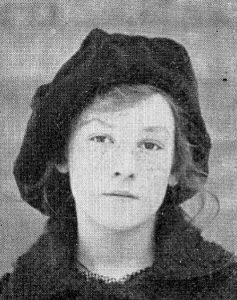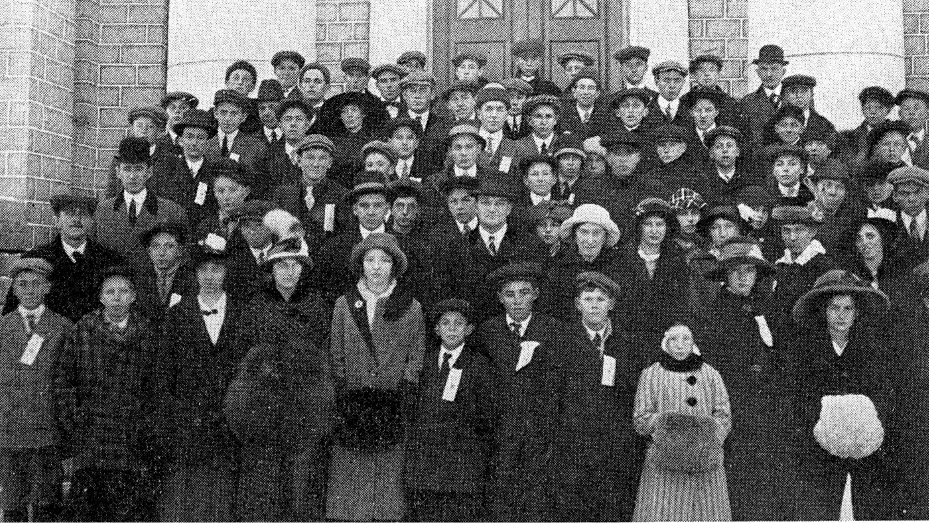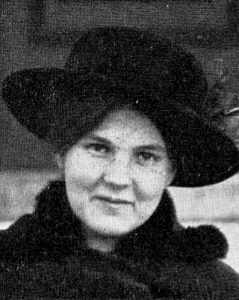4-H Fix: She Set the Bar High!
She Set the Bar High!
By Ron Drum, Statewide 4-H Program Professional/Associate Director 4-H Resource Development
In the photographs we have of her, she looks to be rather small, perhaps only 5 feet tall, if that. But what she lacked in stature she made up for in energy, enthusiasm, and leadership. She was the first Maine 4‑H’er to be named a statewide winner or “champion.” In fact, she earned top placing three of the first four years of 4-H Club work in Maine, setting the bar pretty high for those who would follow!

Emily Estella Morse was born on February 12, 1904, in Cherryfield, Maine, a Washington County town situated on the Narragaugas River. She was the only child of Winfield George and Alta Dehlia Morse. Her father is listed as a farmer on her birth record but later found employment in the lumber industry. His occupation is listed as “lumbering” in “Mills and Woods” on the 1910 census and as “Cook” in “Camp” on the 1920 census.
Emily was ten years old in 1914 when 4-H Clubs (Boys’ and Girls’ Agricultural Clubs in those days) were just getting started in Maine. Records no longer exist (or, at least have not yet resurfaced) for what month the Cherryfield club Emily joined was formed, but their first year must have been successful.
It was especially so for Emily. She was invited to represent her club at the first State Boys’ and Girls’ Clubs Contest held December 21-23, 1914, on the UMaine Orono campus. This event was the beginning of her successes for not only did she attend, but it was during this event she was named the state’s first winner in Gardening and Canning — Maine’s first state champion even though that term was not yet used.


In 1915, she was chosen to attend the State Contest again. This time they began to use the title “champion” for the winners but, even though Emily was awarded a score of 100 on her 10 exhibited jars of fruits and vegetables (worth 20% of the score) and her story was deemed to be the best submitted (worth 20%), the title of Gardening and Canning Champion went to Aroostook County’s 12-year-old Crystal Waddell of Mapleton.
One of the selling points for involvement in early club work was that money could be made through the project work. Crystal reported a 1915 profit of $39.03 (worth 30%) on her 10th-acre of beets after covering her expenses, including 20 cents an hour for her own labor. “Production” was the final 30% of the score. Of her project, Crystal wrote:
If I don’t succeed
In making my beets beat,
I’ve had the fun of trying
With good profits for a treat.

Undaunted, even by poetry, twelve-year-old Emily worked hard through 1916 and was, once again, invited to attend the state contest that December, for a third year in a row. For the second year in a row, her story was deemed to be the best submitted and this time, as noted on page 5 of the December 30, 1916 edition of the Bar Harbor Times, she was designated as the State Canning Champion joining her fellow champions of 1916: Alma Davis, Machias, Poultry; Dorothy Shackford, Ellsworth, Pig Raising; Milfred Blackstone, Perham, Potato Raising; and Hilda Sullivan, Orono, Gardening.
 Her award-winning essay about her work through the summer and fall of 1916 was published on page 1 of the Extension Newsletter No. 30, Boys’ and Girls’ Clubs series no. 11, January 1917. I’ve included it just as it appeared in the Extension Newsletter, but be careful reading it. I don’t know how it will affect you, but it made me hungry!
Her award-winning essay about her work through the summer and fall of 1916 was published on page 1 of the Extension Newsletter No. 30, Boys’ and Girls’ Clubs series no. 11, January 1917. I’ve included it just as it appeared in the Extension Newsletter, but be careful reading it. I don’t know how it will affect you, but it made me hungry!
One other note: in the story Emily says she canned “a total of 20 different kinds of vegetables, 18 kinds of fruit, 1 kind of fish and 1 kind of poultry.” However, when I count the vegetables and fruit listed, I count 16 vegetables and 9 fruit. Since this was determined to be the best story, either I’m not reading this correctly or something is wrong. I can’t believe such a discrepancy would not have been noticed, leading me to think there must be another explanation. My source for the story is the Extension Newsletter, not the original story. I wonder if a line or two was missed when the story was retyped from the original into the newsletter! At any rate, here is her story, as it appeared in the newsletter.
I began my work in canning on June 30th. On that day I picked and canned five quarts of wild strawberries, and sold the same for $1.75. A few days later I canned nine quarts of cultivated strawberries for my mother. All through the summer she went around on crutches while recovering from an operation on her foot. My father was away from home every day and the canning fell to me. This may look to be quite a task for a little girl, but I am proud to tell you that I canned 227 quarts of fruits, meats, and vegetables. Here is a list of the vegetables I have canned this summer: 13 quarts of beets, 54 quarts of beans, 23 quarts of peas, 10 quarts of carrots, 7 ½ quarts of corn, 3 ½ quarts of beet greens, 7 quarts of sour pickles, 9 quarts of sweet pickles, 4 quarts of tomato pickles, 3 quarts of pumpkin, 3 quarts of squash, 1 quart of cabbage, 1 quart of red peppers, 1 quart of cauliflower, and 4 quarts of potatoes.
Besides these I have several quarts of fruits that I must tell you about. I canned and sold five quarts of wild strawberries which I mentioned at the beginning of my story. I have nine quarts of raspberries which I picked and canned with these same little fingers, and 20 quarts of blueberries. Some people say they do not like blueberries in the winter, but I think they make just as good a pie as they do when picked fresh in the summer. I have 3 quarts of Wealthy apples and 4 quarts of Highland cranberries, 3 quarts of peaches, 2 quarts of pineapple, and 8 quarts of crabapples. I also have trout, chicken, turnip greens, and beet greens. This makes a total of 20 different kinds of vegetables, 18 kinds of fruit, 1 kind of fish and 1 kind of poultry.
People say to me, “What kind of jars do you use?” Here is a list of the jars that I used this season: the Queen, the Lightening, the E.Z. Atlas, the Imperial, the Safety Valve, the Sure Seal, the Mason, and the Economy.
This makes eight different kinds of jars, and my choice among them is the Economy jar.
Last year I took some of my canned fruits and vegetables to the fair and won second prize of $3.00 on them. This year our local leader thought the club ought to show some of its work in canning on the fair grounds. I being the President went around among the members and told each one to get some jars ready. When the day of opening came we went to the grounds with our collection of preserves, but we had a hard time finding a table to use for our exhibit. After a long search we found one that was very large, and we arranged our things as pretty as we could. Then the fun commenced. Someone would come along, pick up the jars, turn them upside down and all ways, set them down with a bang and say, “Well, these little girls do fine work.” Then they would turn to someone else and say, “Do you suppose these children do this work?” And the answer would be, “No, I don’t.” This made us feel pretty bad, but after a little while four or five other ladies would come along. I expected to hear the same remark, but this time it was, “Say, look here. This work is done by the Girls’ Agriculture Club. I think this club work is fine for the boys and girls. New clubs are being formed all through the states, they say, and they are doing wonderful work.” This sounded good to me, and I stepped up close to the lady who spoke the encouraging words. The difference in these two ladies makes me think of a motto I have been told many times, “If you cannot say a word that encourages, do not say a word that discourages.”
This is all I have to say about my work this season. I wish all the club members another prosperous season and hope to meet you all again next year doing the club work.
Spoken like a true champion! As the Newsletter said, “…Emily is surely the princess of all canners.” She proved this again by winning again in 1917, now reaching state-wide fame. The Daily Kennebec Journal, January 16, 1918 edition, reported (although with a few errors either on their part or provided to them; Emily’s middle initial was “E”, Her father’s name was Winfield [although he may have been using “Winslow” at this time; being listed as such in the 1910 census], and although 1917 is the third time she was designated as state winner or “Champion” it was not consecutive [1914, 1916, 1917].):
Miss Emily B. Morse, the 13-year-old daughter of Mr. and Mrs. Winslow Morse of Cherryfield, again won the Boys and Girls Agricultural and Canning Clubs contest, this being the third consecutive year in which she has carried off this honor. Miss Morse attended the State Meeting of Clubs at Orono in December and read an interesting paper on her season’s work. Miss Morse won several prizes in the Washington County contests for 1917.
The “Princess of all Canners,” now 14, missed being designated as “Champion” during the December 1918 State Contest, that honor going to Penobscot County’s Marion Griffin of Levant. Too bad, too. This time Emily canned “over 600 pints” (over 300 quarts) according to Extension Newsletter #68, Boys and Girls Clubs Series #25, January 1919. Although she would have been eligible to continue with 4-H membership another four years, through 1922, it is uncertain if she did so based on records discovered so far.
On January 29, 1924, Emily married Mark J. Murdock, a Canadian by birth who was seven when he arrived in the United States in 1909, and the couple moved to Portland, Maine. They had three children: Martin W. born 1925, Richard S. born 1926, and Charles E. born 1929. The 1940 census finds the family living in Boston, MA, Mark listed as a welder and Emily as a housewife with one year of college education. Mark was 76 when he died in 1978 and Emily died July 12, 1986 in Woburn, MA at age 82. They are both buried in Calvary Cemetery in South Portland.
Newspaper and other records searches return very few additional details of Emily’s life after her marriage. From what little that has been found, we may assume she experienced both the happy and sad times that come with births, weddings, job changes, illnesses, and deaths; the life occurrences that we all experience; a life much like the life any of us might lead.
However, for five years, as she moved from childhood into her teenage years, Emily served as a noted role model, continuously working to make her best better. We are left to wonder what those five years of Girls’ Canning Club membership and successes meant to Emily; how they impacted her life, if at all; did they make a difference? I suppose we’ll never know for sure but what we do know is that her Girls’ Club efforts and achievements made a difference in the life of Maine 4-H! Her achievements boosted the Club Work of Maine when it was still in its infancy, when it truly needed boosting, by being a shining example of the “wonderful work” the club members could achieve. She was a role model then and she remains one today! She made a difference then and continues to make a difference today.
Hers was a 4-H Membership that truly set the bar high right from the start!
How are you making a difference in the life of 4-H? Drop me a line and let me know. With your permission, your comments may end up in a future 4-H Fix!
March is Women’s History Month so return to The 4-H Fix on March 10 to read about women who had an impact on Maine 4-H.
Were you a 4-H Member?
 UMaine 4-H wants to hear your story. Please take a moment to fill out our short form and Tell Us Your Story!
UMaine 4-H wants to hear your story. Please take a moment to fill out our short form and Tell Us Your Story!
University of Maine Cooperative Extension conducts the state’s most successful out-of-school youth educational program through 4-H, a youth development program that has been empowering young people in Maine to reach their full potential since 1913.
